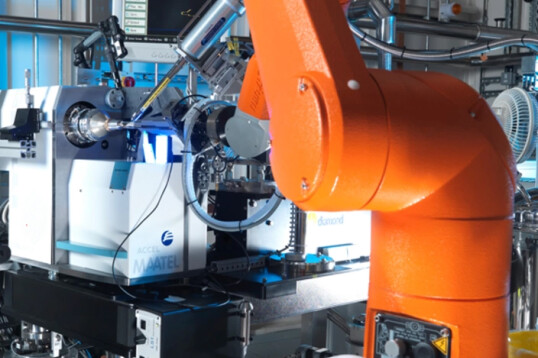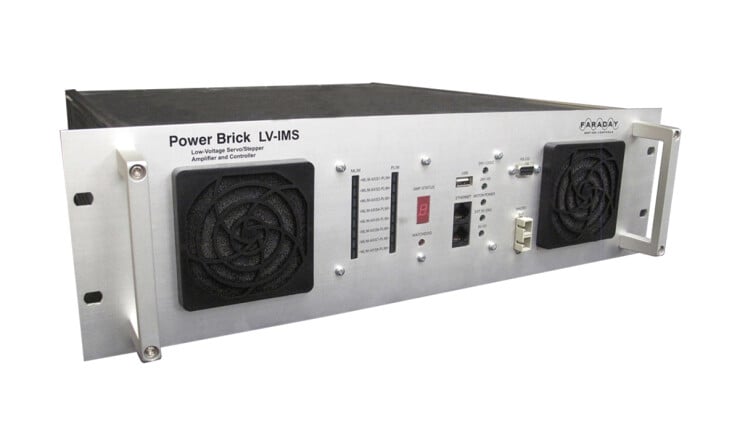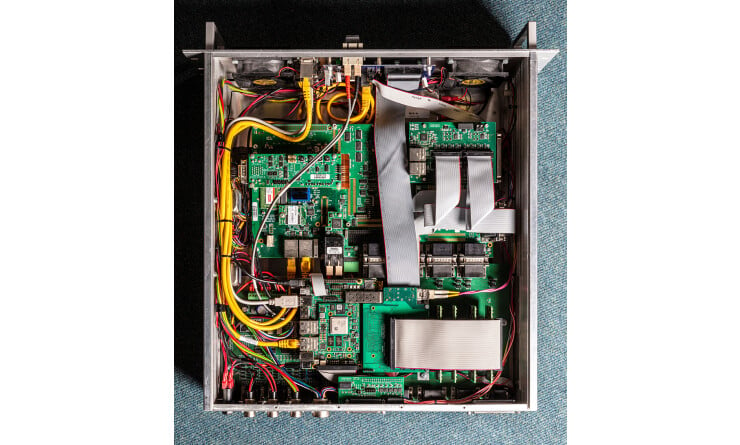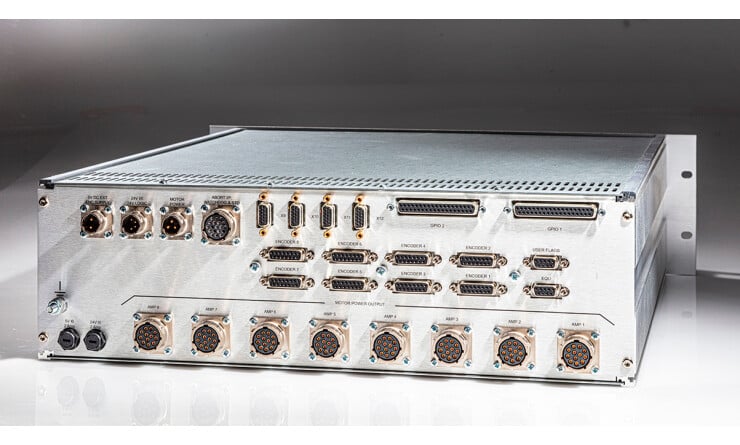Power Brick LV IMS
The Power PMAC is a Motion Controller and Linux computer rolled into one.
GET IN TOUCH ABOUT THIS PRODUCTNow with EPICS and TANGO compatibility running onboard or remotely, the new Power Brick LV-IMS offers the scientific communities around the world a powerful integrated package.
Using fully programmable four-quadrant four-phase technology in the eight axis amplifier stage, the power PMAC-LV-IMS is capable of running any mix of stepper, AC servo or DC servo motors. Having unique software control of the current in each axis allows the user to fully customise each application. Each block of four axes comes in three different current ratings of: 0.25A continuous 0.75A peak; 1.0A continuous 3.0A peak; and 5.0A continuous 15A peak. All current ranges operate between 12 and 48VDC.
As well as standard quadrature encoder inputs, both versions come complete with a range of serial encoder interfaces. These include Endat 2.2, Hiperface, SSI, Yaskawa Sigma II, and Tamagawa. For more recent and future protocols, not included in the DSPgate3, provision has been made to fit a mezzanine board to facilitate the use of these and analogue sin/cos and resolver feedback devices.
The Delta Tau MACRO (Machine And Control Ring Optical) interface now comes as standard, enabling the controller to control 32 axes. It also allows any Delta Tau MACRO product such as I/O, analogue interfaces or amplifiers to be added to the systems.
Product benefits
Five built-in control algorithms
Accurate
contouring
Position, torque,
and backlash
compensation
Multiple safety features
Download the Power PMAC PDF for a detailed overview
Product features
Control Algorithms
- Standard PID only
- PID enhanced with notch filters, deadband filters, lowpass/highpass filters, velocity loop filters, and/or trajectory prefilters
- Standard Gantry Control
- Cross-Coupled Gantry Control
- Adaptive Control
Motor Servo Control
- Extremely fast update rates (Phase and Servo)
- Standard PID with full feedforward model
- Powerful automatic tuning and analyser tools
- Analog, Pulse Width Modulated (PWM), Pulse Frequency Modulated (PFM), MACRO or EtherCAT Outputs
- Vibration suppression filters
- Multiple 7th order notch and low pass filters
- Adaptive control for varying loads
- Cascaded loops (force, height, camera auto-focus control)
- Support for custom-written commutation routines
- Support for custom-written servo routines
- Custom routines directly in
Coordinate Systems
- Up to 256 axes of coordinated or independent motion
- Up to 128 independent coordinate systems
- Up to 32 independent axes per coordinate system
- Dynamic axes transformations (e.g. offsets, rotations, mirroring)
- Forward/Inverse kinematics for nonlinear mechanisms
- User defined routines convert between tool tip coordinates and actuator positions
- Permit
Programmable Logic Control (PLCs)
- Access to all registers
- Trigonometric, transcendental, vector and matrix functions
- 64-bit floating-point architecture optimized math
- Executive functions for standalone operation
- Data gathering of up to 128 hardware/ software registers per servo cycle
- Program in PMAC Script
- Program in ANSI C:
- Real time with pre-emptive kernel routines
- General purpose routines
- MATLAB®/Simulink® Embedded Coder® generated code
Electronic Gearing and Cams
- Powerful master/slave techniques
- Position following (gearing) requires no program for motion
- External time base (cam) keeps full trajectory flexibility (non-returning, limited reversal, e.g. moving web application)
- Up to 256 cam tables (16k points each)
- Position/torque profile(s)
- Returning, forward/reverse travel
- Extremely precise synchronized outputs
Trajectory Generation
- Auto-coordination of multiple sets of axes
- Linear, circular, rapid, position-velocitytime (PVT), LIN to PVT (curve fit), Spline move modes
- Seamless blending between linear, circular and PVT modes
- Automatic move until trigger (hardware input)
- True S-Curve accel / decel
- All move modes supported with user kinematics
- Dynamic multi-block lookahead with velocity/acceleration control and jerk limit
- Sub-millisecond segmentation time
- Negative feedrate for true motion reversal in lookahead
- Move block execution rate up to 10,000 blocks/sec
- G-code, M-code, and T-code ready
- Calculations and I/O synchronous to motion
- Tool radius compensation, 2D or 3D
Compensation Tables
- Position/torque compensation tables in 1D, 2D, or 3D with rollover and mirroring options
- 1st/3rd order interpolation between points every servo cycle
- Up to 256 compensation tables (64K each)
- Support for superimposed compensation table results
- Backlash compensation, fixed or in tables Hardware Position Capture and Compare
- Specialised circuitry tying encoder counts to digital I/O
- I/O on exact count (w/sub-count interpolation) at any speed (within 10 nanoseconds)
- For probing, registration, measurement trigger, laser firing
Gantry Control
- Follower motor(s) executes leader’s trajectory
- Automatic skew removal on homing
- Automatic gantry cross-coupling servo correction
Safety Features
- Hardware and software over-travel limits
- Amplifier enable/fault handshaking
- Following error limits
- Integrated current limit
- Encoder loss detection
- Watchdog timer and relay for safely stopping the machine if the controller freezes.






